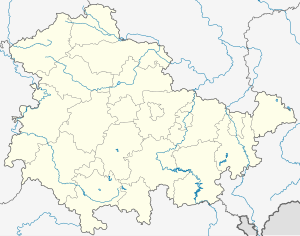Harrasmühlen tunnel
| Harrasmühlen tunnel | ||
|---|---|---|
| use | Railway tunnel | |
| traffic connection | Railway line Leipzig – Gera – Saalfeld | |
| place | Neustadt an der Orla / Oppurg | |
| length | 117 m | |
| Number of tubes | 1 | |
| construction | ||
| start of building | 1871 | |
| business | ||
| release | December 20, 1871 | |
| location | ||
|
|
||
| Coordinates | ||
| West portal | 50 ° 42 ′ 59 " N , 11 ° 41 ′ 46" E | |
| East portal | 50 ° 43 ′ 0 ″ N , 11 ° 41 ′ 58 ″ E | |
The Harrasmühlen tunnel is located between the Neustadt an der Orla train stations (km 109.0) and Oppurg (km 117.7) on the Leipzig – Gera – Saalfeld railway line . The tunnel, which was built for double-track operation, was opened with the line on December 20, 1871, was double-tracked from August 25, 1915 and has been single-track again since the summer of 1946, when one track on the line was dismantled as a reparation payment to the Soviet Union . With a length of around 117 m, it was one of the shortest of the 28 tunnels of the Reich Railway Directorate in Erfurt .
The tunnel was built in 1871 according to the Belgian tunnel construction method and is lined along its entire length. The overburden rises on both sides up to approx. 17.5 m above the top of the vault. The highest point in the area is 295.06 m above sea level .
The main dimensions are: width 8.10 to 8.20 m; Height between the upper edge of the rail and the crown of the vault 6.30 to 6.40 m. As in all tunnels of this time, the track spacing was 3.50 m. The upper edge of the rails is at the Neustädter Portal at 271.04 m and at the Oppurger Portal at 269.88 m above sea level. The tunnel axis has almost exactly the main direction east - west. The tunnel site lies within the municipality of Lausnitz . On the Neustadt side there is a pre-cut of approx. 50 m and on the Oppurger side of approx. 300 m length. The tunnel is located on a continuous slope, on the first 9.05 m with 5.02 per thousand and on the remaining part with 11.25 per thousand. Coming from Neustadt the track lies in a curve with a radius r = 460 m for the first 20 m and then merges into the subsequent straight in a 105 m long transition curve.
Towards the end of World War II , aerial bombs were dropped on the tunnel twice . One time it was about an ammunition train that was partially stopping in the tunnel, the other time the attack was probably aimed at the nearby copper hammer.
When the general inventory of the Reichsbahn assets was taken in October 1960, the new construction costs of the tunnel were set at 283,800 marks and its expected service life at 180 years.
Web links
- Karlheinz Dörner: Route 6383: Tunnel at the Harrasmühle azf eisenbahn-tunnelportale.de, accessed on May 15, 2014
